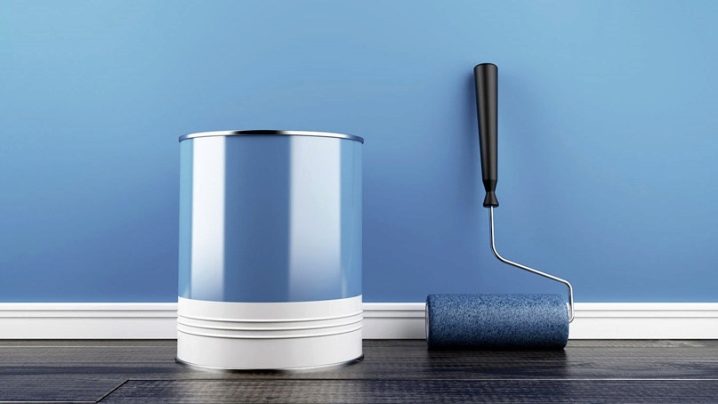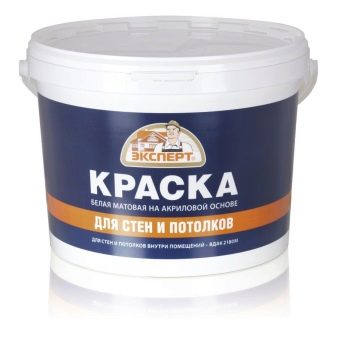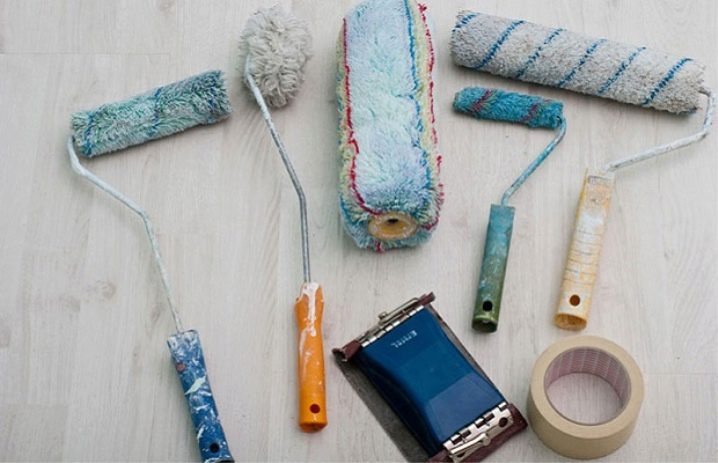What roller to paint the ceiling: choosing a tool for water-based paint

Ceiling painting is one of the basic steps in the renovation process. The quality of the work done depends not only on the coloring composition, but also on the tools used to apply them. Most often, rollers are used to process the ceiling. Using these tools, you can evenly and correctly distribute the composition over the surface, without leaving streaks and other defects.
Types of emulsion paint
Before you get acquainted with the peculiarities of choosing paint rollers, you need to understand what emulsion paints are. It is worth noting that it depends on the type of composition which tool will be used in the staining process.

Today there are four types of emulsion paints. The difference between all options lies in the presence of a polymer in the composition.
- One of the most popular types are acrylic paints, which are used by both experienced and novice craftsmen. It should be noted that these compositions are suitable for different types of surfaces, which can be attributed to their main advantage. The main component in these paints is acrylic resin. It is this substance that ensures the high performance of the composition.
- The following view is - silicone water-based paints... This is ideal for rooms where the humidity level is quite high. The composition of paints is dominated by such a component as silicone resin. It should be noted that these options are ideal for masking small defects on ceilings.


- No less versatile are silicate paints... They are based on liquid glass, supplemented with various color pigments. The main distinguishing features of these paints are durability and resistance.
- The last view is mineral paints... In the production process, slaked lime is added to the compositions. Often, manufacturers replace this option with cement. The versatility of mineral paints lies in the fact that they are used both for walls and for painting ceilings. They are most often used for painting concrete and brick surfaces.


Roller types
After familiarizing yourself with the main types of emulsion paints, you need to figure out which roller will be most suitable for processing the ceiling. It is worth noting that many people replace this tool with a brush or spray gun. But you need to understand that painting the ceiling with the first type will take too long. As for the spray gun, this option is convenient and practical, but the device itself is quite expensive.

If we talk about rollers for water-based paint, then today manufacturers produce tools from pile and foam rubber... Also in stores you can find fixtures made of polyamide and velor. The cost of each of the options is not too different from each other. Despite this, the rollers have individual properties.

Foam tools are most often used for applying varnish and glue. But experts recommend not to rush to choose this option for a water-based composition.
This is due to the following points:
- material quickly absorbs paint;
- during operation, the composition flows abundantly from the foam rubber;
- the roller is not durable.


In addition, in the process of use, foam rubber quickly loses its original properties.
The next type is lint tools.These are versatile options that are used for all types of ceilings. The rollers can be of different lengths, which is quite convenient when working with formulations. For water based paints, it is best to choose tools with medium bristles. Such a pile, in comparison with a short one, will not absorb moisture.

A velor roller is ideal for working with water-based formulations. The tool can be used on various coatings, the material perfectly resists the effects of aggressive components. Compared with the previous versions, these rollers do not have serious disadvantages. But if you intend to paint the ceiling with a tool, be prepared for the fact that the device will often need to be dipped into the water-based composition, since the velor quickly absorbs the mixture.
As for polyamide rollers, textiles are used to create them. During production, the material is stitched with threads. These tools are mainly used by professional painters.


Features of the choice of tool
When choosing a roller for painting the ceiling, you should pay attention to a few more important points. Considering all of the above features of each of the species, the process of acquiring a suitable device will not take too long. However, there are some minor nuances.
In the process of choosing a roller, be guided by the type of surfacethat you will have to work with. As mentioned above, some of the best types for all coatings are pile rollers. Please note that if you are painting the ceiling with a rough texture, it is best to choose tools with long bristles. With this tool, you can easily fill in all the irregularities.


If you still prefer a budget foam roller, it is worth checking the quality of the material even during the selection of the device. Start by squeezing the working end firmly in your hand. Even under strong pressure, the foam should not deform.
Particular attention must be paid to the seam on the material. The presence of a clear joint can affect the quality of the paint.
Choosing the right paint utensils is also important. Experts recommend purchasing high-quality containers specially designed for repair work.


Basic painting rules
After purchasing everything you need, you can start processing the ceiling. To begin with, the surface must be carefully prepared so that in the future the paint will lay down evenly. The ceiling must be cleaned, getting rid of the old finish. You also need to patch up the cracks so that the surface becomes perfectly flat. Please note that during preparation, the ceiling is rubbed with sandpaper.
If you decide to whitewash the surface, it is best to use a primer. After preparing the surface, you can start painting.

To begin with, the composition is diluted to obtain a suitable consistency, focusing on the instructions specified by the manufacturer. Most often, up to 10% water is added to water-based mixtures. Sometimes the composition is stirred with a drill attachment without adding liquid.
It is necessary to start staining from hard-to-reach places. This includes corners and curbs. Particular attention must be paid to hard-to-reach places in multi-level structures. In these cases, paint should also be applied to the protruding elements. If you cannot do this with a roller, it is best to use a brush.

After processing all the elements, the ceiling must be painted with a roller. Please note that when working with a water-based composition, the tool must be dipped, not dipped in a container. Thanks to this, the paint will not drip from the roller and will be evenly distributed during application.
All work must be done at a fast pace. The composition must be applied evenly so that the process does not drag out, the lines are distributed evenly to each other.Each next strip should cover the previous one. The composition is thoroughly rubbed over the surface to prevent rapid drying at the edge.


Helpful hints
If you are still undecided on the choice of a suitable tool, there are several significant features worth paying attention to.
First you need to say that for large areas it is always best to use a roller... Using these tools, you can quickly and efficiently paint the ceiling without leaving streaks. Working with a brush, you will constantly encounter drips, in addition, the process will take a lot of time and effort.

The extended handle makes painting much easier. You can effortlessly process the composition of the ceiling without the help of a stepladder. It is almost impossible to do this with other tools.
When choosing a nap roller, be sure to pay attention to the fact that during operation, soft bristles may remain on the ceiling. Therefore, immediately buy a quality tool that will not have such problems.

While working with the roller, periodically move away from the treated area. Viewing the ceiling from different angles will help you assess the quality of the staining, as well as not miss the defects. If, at the end of the work, you notice poorly treated areas, sandpaper with a large number will help fix the problem.
Particular attention should be paid not only to the tool, but also to the paint. The whole process must be performed using the composition of one brand. Otherwise, the end result will definitely not be able to pleasantly surprise you. When choosing a paint, it is also worth focusing on the type of surface.


For information on which roller to paint the ceiling, see the next video.







The comment was sent successfully.